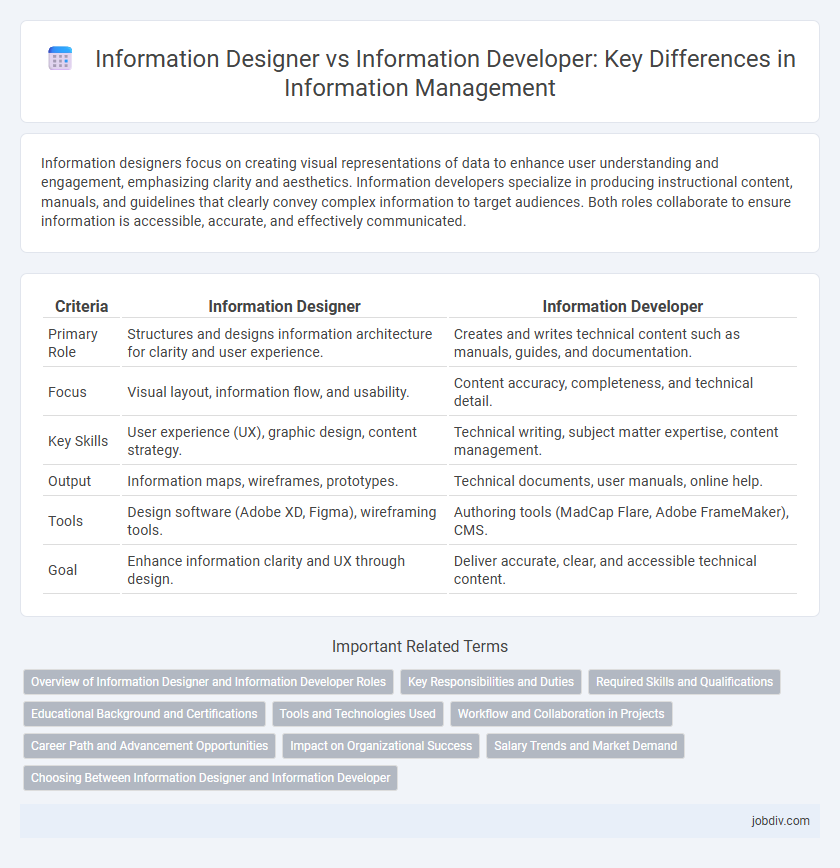Information designers focus on creating visual representations of data to enhance user understanding and engagement, emphasizing clarity and aesthetics. Information developers specialize in producing instructional content, manuals, and guidelines that clearly convey complex information to target audiences. Both roles collaborate to ensure information is accessible, accurate, and effectively communicated.
Table of Comparison
| Criteria | Information Designer | Information Developer |
|---|---|---|
| Primary Role | Structures and designs information architecture for clarity and user experience. | Creates and writes technical content such as manuals, guides, and documentation. |
| Focus | Visual layout, information flow, and usability. | Content accuracy, completeness, and technical detail. |
| Key Skills | User experience (UX), graphic design, content strategy. | Technical writing, subject matter expertise, content management. |
| Output | Information maps, wireframes, prototypes. | Technical documents, user manuals, online help. |
| Tools | Design software (Adobe XD, Figma), wireframing tools. | Authoring tools (MadCap Flare, Adobe FrameMaker), CMS. |
| Goal | Enhance information clarity and UX through design. | Deliver accurate, clear, and accessible technical content. |
Overview of Information Designer and Information Developer Roles
Information Designers focus on structuring, visualizing, and presenting data to enhance user comprehension and engagement, often employing graphic design and content strategy techniques. Information Developers create, manage, and maintain technical content such as manuals, help guides, and documentation, ensuring accuracy and clarity for diverse audiences. Both roles are essential in delivering clear and effective information, with designers emphasizing presentation and developers concentrating on content creation and usability.
Key Responsibilities and Duties
Information Designers focus on creating clear, engaging visual content to communicate complex data effectively, including infographics, charts, and digital layouts. Information Developers specialize in producing and managing comprehensive technical documentation, user manuals, and instructional materials tailored to target audiences. Both roles require strong collaboration with subject matter experts to ensure accuracy and clarity in delivered content.
Required Skills and Qualifications
Information Designers require strong skills in visual communication, user experience (UX) design, and information architecture, emphasizing the ability to create clear and engaging visual content. Information Developers need expertise in technical writing, content management systems, and understanding complex technical subjects to produce accurate and accessible documentation. Both roles demand proficiency in collaboration tools and a solid foundation in research and communication techniques.
Educational Background and Certifications
Information Designers typically hold degrees in graphic design, communication, or human-computer interaction, emphasizing visual communication and user experience principles. Information Developers often possess educational backgrounds in technical writing, computer science, or information technology, focusing on content creation, documentation, and software development. Certifications such as Certified Technical Communicator (CTC) benefit Information Developers, while Information Designers may pursue credentials like Adobe Certified Expert (ACE) to validate design software proficiency.
Tools and Technologies Used
Information Designers primarily use design software such as Adobe Creative Suite, Sketch, and Figma to create visually compelling and user-centric information displays, while incorporating data visualization tools like Tableau or Power BI for enhanced comprehension. Information Developers focus on tools oriented towards content creation and management, including Markdown, XML, content management systems (CMS) like WordPress or Drupal, and authoring tools such as MadCap Flare or Adobe RoboHelp for technical documentation. Both roles leverage collaboration platforms like Confluence and version control systems such as Git to streamline workflow and ensure consistency in information delivery.
Workflow and Collaboration in Projects
Information Designers focus on creating clear, user-centered visualizations and interfaces by collaborating closely with UX researchers and stakeholders during the initial design phases. Information Developers specialize in producing detailed technical content, manuals, and documentation that align with development workflows and require coordination with engineers and product managers. Effective project collaboration involves iterative feedback loops where Designers and Developers exchange insights to ensure accuracy and user comprehension throughout the content lifecycle.
Career Path and Advancement Opportunities
Information Designers specialize in crafting clear, user-friendly visuals and content to communicate complex data effectively, often progressing into roles such as User Experience (UX) Designer or Content Strategist. Information Developers focus on creating and managing technical documentation, software manuals, and help systems, with career advancement typically leading to Technical Writing Manager or Documentation Specialist positions. Both career paths emphasize strong communication skills, but Information Designers trend toward creative design fields while Information Developers lean heavily on technical expertise and software knowledge.
Impact on Organizational Success
Information Designers enhance organizational success by creating visually compelling and easily navigable content that improves user comprehension and engagement, leading to better decision-making and efficiency. Information Developers contribute by producing clear, structured documentation and training materials that ensure consistent knowledge transfer and skill development across teams. Both roles drive organizational impact through effective communication strategies that optimize information delivery and utilization.
Salary Trends and Market Demand
Information Designers command competitive salaries, typically ranging from $70,000 to $110,000 annually, driven by their expertise in user experience and data visualization in sectors like technology and marketing. Information Developers often earn between $65,000 and $105,000, with strong demand in software documentation and technical writing roles, reflecting the tech industry's expansion. Market trends indicate a growing need for Information Designers due to the emphasis on intuitive data presentation, while Information Developers remain critical in creating clear, accessible content for complex technical products.
Choosing Between Information Designer and Information Developer
Choosing between an Information Designer and an Information Developer depends on the project's focus and objectives. Information Designers specialize in structuring and presenting data visually to enhance user understanding, using tools like infographics and UI elements. Information Developers, on the other hand, create comprehensive documentation and instructional content, emphasizing clarity and accessibility for end users and technical staff.
Information Designer vs Information Developer Infographic

 jobdiv.com
jobdiv.com